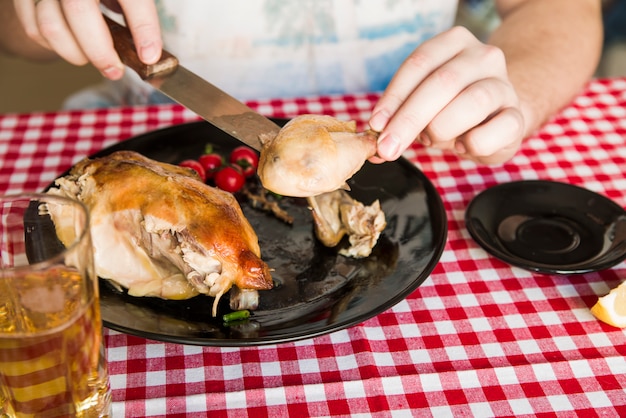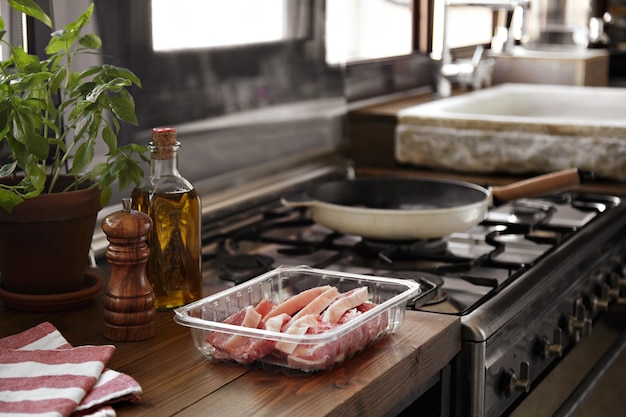Let's be honest, you've probably seen it – that unassuming, maybe even a little intimidating, turkey neck hanging out in the butcher's section. But don't let its appearance fool you. This humble cut of meat is a real hidden treasure, bursting with flavour, surprisingly budget-friendly, and absolutely delicious when cooked right. Now, you might be thinking, "Stovetop? Is that really a thing?" Well, it absolutely is! And it's one of the best ways to unlock that deep, rich flavour you crave. I'm talking about a broth so satisfying, it'll have you wondering why you haven't been using turkey neck all along.
Over the years, I've experimented with all sorts of ways to cook turkey neck. I've braised it, slow-cooked it, even tried pressure cooking it. But nothing comes close to the simplicity and sheer deliciousness of stovetop simmering. It's a method that lets the turkey neck truly shine, revealing a depth of flavour that's just unmatched.
So, grab yourself a turkey neck (or two!), a good pot, and get ready to dive into my foolproof method for unlocking the secrets of stovetop turkey neck cooking.
(Part 1) Unveiling the Secrets of Turkey Neck

What is a Turkey Neck?
Okay, let's start with the basics. A turkey neck is, as you might have guessed, the neck of a turkey. It's a long, cylindrical piece of meat that connects the head to the shoulders. It’s typically covered in skin and a thin layer of fat, which contributes significantly to its rich flavour. It might not look fancy, but believe me, this humble cut has a lot to offer.
Why Choose Turkey Neck?
Now, you might be wondering why you’d bother with turkey neck, especially when there are so many other cuts of meat out there. Let me tell you, it's a real game-changer for a couple of reasons:
- Budget-Friendly: Turkey neck is often one of the cheapest cuts of turkey, making it a real steal for those looking for an affordable way to create delicious dishes. It's like a secret weapon for stretching your food budget.
- Packed with Flavour: Don't let its size fool you. Turkey neck is full of flavour, especially when it’s simmered slowly. It's a fantastic source of umami, that savory, deliciousness that makes your tastebuds sing.
- Versatile: You can use turkey neck for a wide range of dishes. It’s a natural for rich broths and stocks, but you can also use it to add depth to soups, stews, and even gravies. It's truly a multi-talented ingredient.
The Secret to Tender Turkey Neck
Now, the key to cooking turkey neck lies in understanding its texture. It's a tough cut of meat, so it needs some TLC. You need to cook it slowly and gently over low heat to break down the connective tissue and make it melt-in-your-mouth tender. Think of it like a slow dance – a gentle, patient approach is essential for the best results.
(Part 2) Preparing Your Turkey Neck for Stovetop Success

Shopping for the perfect turkey Neck
First things first, you need to find a good turkey neck. Head to your local butcher shop – they'll have the best selection and can give you some great tips. When you’re choosing your neck, look for one that’s plump and has a good amount of meat on it. Avoid necks that are dry or have too much fat, as these might not be as flavourful.
Prepping Your Turkey Neck for Stovetop Cooking
Once you've got your neck, give it a good rinse under cold water. Now, here's the important part: you need to remove any excess fat. You can do this by simply trimming it off with a sharp knife. Don't worry about getting it all; just remove the bigger chunks. You might be surprised by how much fat there is, and it won't be needed for the flavourful broth you'll be making!
Roasting for Extra Flavour
Now, here's a little secret that'll make all the difference in the world: roast your neck before you simmer it. You might be thinking, "Why bother?" Well, it's a game-changer. Roasting adds a layer of deliciousness that you just can't get any other way.
To roast your turkey neck, simply preheat your oven to 400 degrees Fahrenheit (200 degrees Celsius). Rub the neck with a little bit of salt, pepper, and your favourite herbs (I love thyme and rosemary). Then, place it in a roasting pan and roast for about 30 minutes, or until the skin is golden brown and crispy. Now, your turkey neck is ready for the stovetop!
(Part 3) The Stovetop Symphony: Simmering to Perfection

Your Essential Stovetop Equipment
You're going to need a large, heavy-bottomed pot. Something that can handle the heat and won't warp. Also, don't forget a good wooden spoon for stirring and a ladle for serving. You might want to grab a strainer, too, for later on.
The Stovetop Symphony: Getting Started
Place your roasted turkey neck in your pot. Then, add enough water to cover the neck by a couple of inches. Bring the water to a boil over medium-high heat, then reduce the heat to low and simmer for at least 2 hours.
Now, here's where the magic happens. Let your turkey neck simmer away, undisturbed. You can even leave it for longer, up to 4 hours, depending on how tender you want it. The longer you simmer it, the richer and more flavourful your broth will be. Remember, slow and steady wins the race when it comes to turkey neck cooking.
The Art of Skimming: Keeping It Clean
During the simmering process, you'll see a layer of fat rising to the surface. Don't be alarmed, that's completely normal. But to keep your broth clear and prevent it from becoming greasy, skim off the fat using a spoon or ladle. Just gently scoop out the fat as it gathers, and discard it. You'll be surprised how much fat there is, and it will definitely affect the final outcome of your broth!
(Part 4) Enhancing the Flavour: Adding Vegetables and Seasonings
Flavour Boost: The Power of Vegetables
You're not limited to just turkey neck in your broth. For an even more flavourful broth, add your favourite vegetables. I like to add carrots, onions, celery, and garlic. They'll add some sweetness and depth to the broth and make it incredibly satisfying. Don't worry about cooking them through; just add them to the pot during the last 30 minutes of simmering. They’ll release their flavour and add a bit of a delightful crunch!
Seasoning to Taste: A Symphony of Flavour
Now, it's time to give your broth a little extra something. Salt and pepper are a must, of course. But feel free to experiment with other seasonings. A bay leaf is always a good idea, and a pinch of dried thyme or oregano can really add some depth. Just taste as you go and add more seasoning until you're happy with the flavour. Remember, this is your broth, so let your taste buds be your guide!
(Part 5) Time to Harvest Your Broth: Separating and Straining
Separating the Meat from the Broth
After simmering, your broth should be ready. It should have a rich, golden colour and a delicious aroma. But before you can enjoy it, you need to separate the meat from the broth. The easiest way to do this is by carefully lifting the turkey neck out of the pot using a slotted spoon or tongs. Then, set it aside on a plate.
Strain for Smoothness: The Finishing Touch
Now, here's the key to a silky smooth broth: strain it. You can use a fine-mesh sieve or a cheesecloth-lined strainer. Simply pour the broth through the strainer, discarding any solids. You'll be left with a beautiful, clear broth, ready for whatever culinary adventure you have planned!
(Part 6) Mastering the Art of Turkey Neck Broth
Using Your Delicious Broth: A World of Possibilities
You've got your broth! Now, what to do with it? The possibilities are endless! It's the perfect base for hearty soups, comforting stews, and delicious gravy. You can also use it to add flavour to rice dishes, pasta sauces, or even as a marinade for chicken or pork. The possibilities really are endless!
Freezing for Future Use: Saving Your Broth for Later
If you have more broth than you can use immediately, don't fret! It freezes beautifully. Just pour it into airtight containers and freeze for up to 3 months. When you're ready to use it, just thaw it in the fridge overnight and you'll be good to go. Always make sure you label your containers with the date so you know how long it's been in the freezer.
(Part 7) Beyond the Broth: Creative Uses for Turkey Neck
Savory Turkey Neck Dishes: Unlocking New Flavours
You can also enjoy the turkey neck itself! It's tender and flavourful, and it can be used in a variety of dishes. Here are some ideas:
- Turkey Neck Tacos: Shred the cooked turkey neck and use it as a filling for tacos. Top with your favourite toppings, like salsa, guacamole, and sour cream. It's a real crowd-pleaser!
- Turkey Neck Salad: Shred the cooked turkey neck and add it to a salad for extra protein and flavour. It's a great way to use leftover turkey neck.
- Turkey Neck Pasta: Shred the cooked turkey neck and add it to a pasta dish. It's a simple but delicious way to add some protein and flavour to your pasta.
- Turkey Neck Pizza: Shred the cooked turkey neck and add it to a pizza for a unique twist on a classic. It's a great way to add some protein and flavour to your pizza.
Table of Turkey Neck Cooking Times: A Quick Guide
Here's a handy table to help you with your turkey neck cooking journey:
| Cooking Method | Time |
|---|---|
| Stovetop Simmer (Low Heat) | 2-4 hours |
| slow cooker (Low Heat) | 6-8 hours |
| pressure cooker | 30-45 minutes |
Just remember to adjust the cooking times based on the size and thickness of your turkey neck. It's always better to err on the side of caution and cook it a little longer than to risk it being undercooked.
(Part 8) FAQs: Unveiling the Turkey Neck Mysteries
What if I don’t have a butcher shop?
Don’t worry, you can find turkey necks at most grocery stores. Just look in the section with the other poultry. If you can’t find one, ask a staff member; they’ll be able to point you in the right direction.
How do I know when my turkey neck is done?
The meat should be tender and easily pull away from the bone. If you can’t easily shred it with a fork, it needs to cook a little longer. If you’re unsure, you can always cut into the meat to check.
Can I use the turkey neck bones for broth again?
Absolutely! You can use the turkey neck bones to make a second batch of broth. Just rinse them off and repeat the simmering process. You’ll get a slightly weaker broth, but it’s still delicious.
What else can I add to my turkey neck broth?
You can add any vegetables you like. Some popular additions include carrots, celery, onions, garlic, ginger, leeks, and tomatoes. You can also experiment with herbs and spices, such as bay leaves, thyme, oregano, rosemary, and peppercorns. Let your taste buds guide you!
How long can I store turkey neck broth in the fridge?
You can store turkey neck broth in the fridge for up to 4 days. Just make sure to store it in an airtight container. If you’re planning to store it for longer, it’s best to freeze it.
There you have it – a complete guide to the wonders of turkey neck. You’ve got the tools, the knowledge, and the confidence to create some incredible culinary magic. So, next time you see a turkey neck in the butcher’s section, don’t shy away. Embrace it! This hidden gem is waiting to be discovered, and it’s ready to add a whole new layer of flavour to your cooking!
Everyone is watching

Prime Rib Roast Cooking Time Chart: Per Pound Guide
Cooking TipsPrime rib roast. Just the name conjures images of lavish dinners, crackling fires, and hearty laughter. It’s ...

How Long to Bake Potatoes in the Oven (Perfect Every Time)
Cooking TipsBaked potatoes are a staple in my kitchen. They're incredibly versatile, delicious, and surprisingly easy to m...

Perfect Rice Every Time: The Ultimate Guide to Cooking Rice
Cooking TipsAs a self-proclaimed foodie, I've always been a bit obsessed with rice. It's the foundation of countless cuisi...

The Ultimate Guide to Cooking Asparagus: Tips, Techniques, and Recipes
Cooking TipsAsparagus. The mere mention of this spring delicacy conjures up images of vibrant green spears, crisp and burs...

Ultimate Guide to Cooking the Perfect Thanksgiving Turkey
Cooking TipsThanksgiving. Just the word conjures up images of overflowing tables laden with delicious food, the scent of r...
